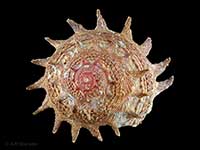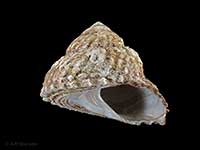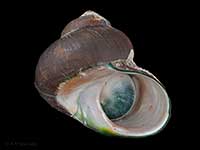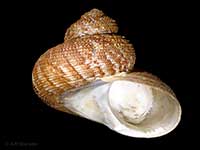Mollusca (Phylum) > Gastropoda (Class) > Vetigastropoda (Subclass) > Trochida (Order) > Trochoidea (Superfamily) > Turbinidae (Family)
 Filter region:
Filter region: 
(greyed out images not recorded from filtered region)
 Click here to filter list on Geographical Range
Click here to filter list on Geographical RangeFamily: Turbinidae
- Astraea heliotropium (Martyn, 1784)
Width 120mm, Height 60mm
Circular Saw Shell, Marine, Native - Endemic
North, South, Stewart and Chatham Islands
ACFM - Bolma kermadecensis Beau & Ponder, 1979
Width 47mm, Height 36mm
Marine, Native - Endemic
Kermadec Islands, 135-210 metres
K - Bolma recens Dell, 1967
Marine
Norfolk Islands, Wanganella Bank, and Kiwi Seamount, northern Three Kings Rise
A - Cookia sulcata (Lightfoot, 1786)
Width 124mm, Height 90mm
Cooks Turban Shell, Marine, Native - Endemic
North, South and Chatham Islands
ACFM - Lunella smaragda (Gmelin, 1791)
Width 91mm, Height 84mm
Common Cats Eye, Pupu, Marine, Native - Endemic
North, South and Stewart Island. Also recently recorded from the Chatham Islands
ACFM - Modelia granosa (Martyn, 1784)
Height 92mm, Width 90mm
Southern Cats Eye, Marine, Native - Endemic, Low tide to about 40 metres. More common in the south where it usually grows to a larger size
North, South, Stewart and Chatham Islands
ACFM
Key to Geographical Ranges

The symbols K.A.C.F.M.An. are used to indicate the geographical range of the species.
They have been adopted to give an approximation of the range of each species within New Zealand.
K=
Kermadec Islands
A=
Aupourian - Kaipara Harbour, north around North Cape, encompassing the Three Kings Islands and south to East Cape
C=
Cookian - Lower North Island and the northern part of the South Island
F=
Forsterian - Otago, Fiordland and Stewart Island
M=
Moriorian - Chatham Islands, Pitt Island
An=
Antipodean - Subantarctic Islands of New Zealand
Fw =
Freshwater
L =
Land
N =
North Island
S =
South Island
R =
Recent
Sf =
Subfossil
Fo =
Fossil





